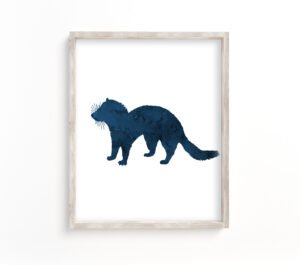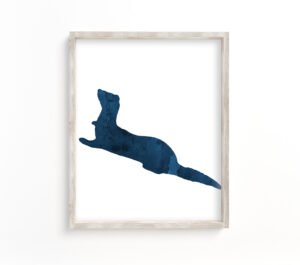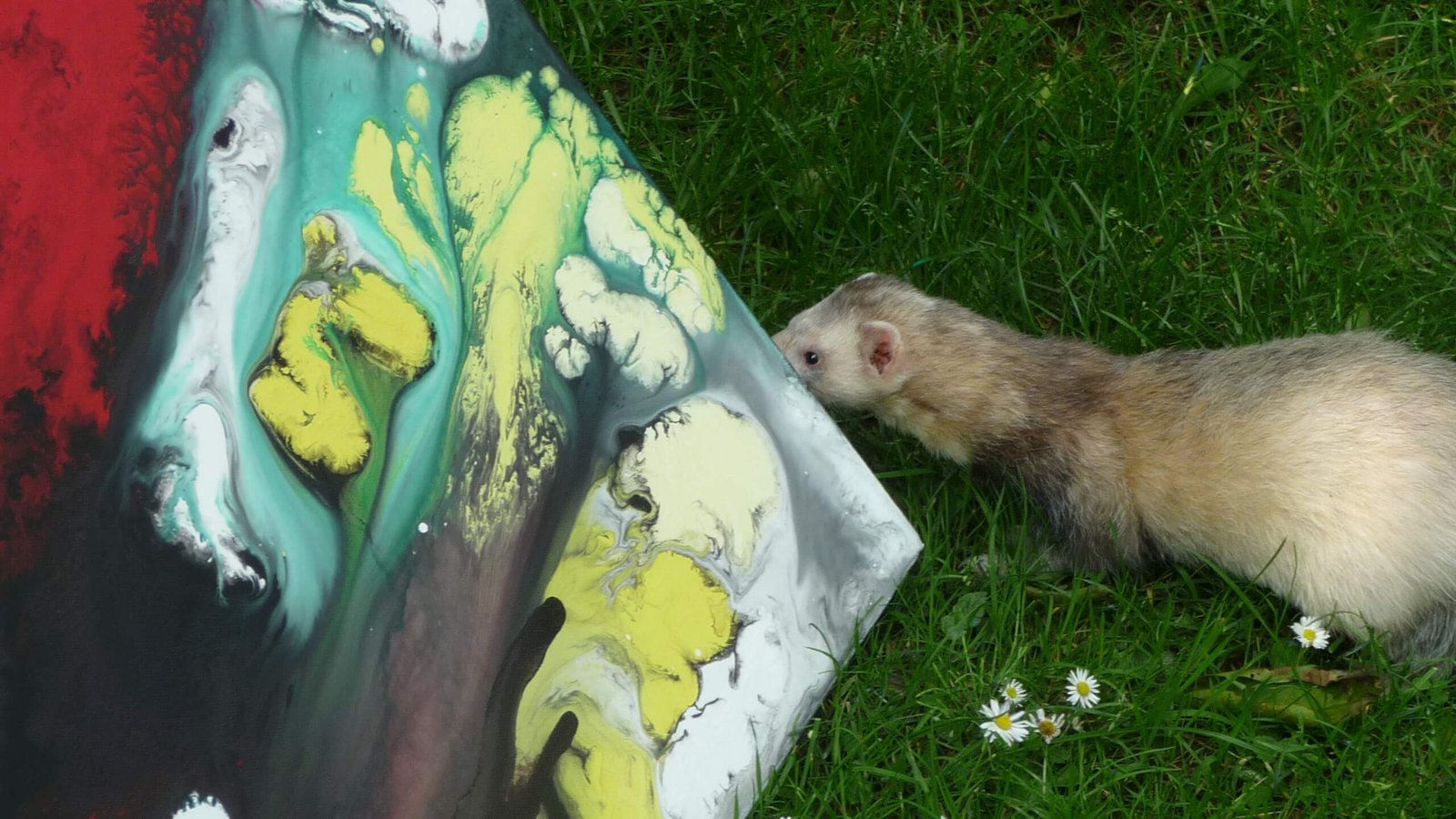The Ferret Diet - What Do Ferrets Eat?
Ferrets are obligate carnivores and must eat meat. In nature, ferrets (polecats) prey on rodents (like mice or rabbits), amphibians, birds, insects, and even small snakes. They can’t digest plant matter like vegetables, fruits, and grains on their own. Feeding plant matter might lead to illness, poor coat, and inactivity.
This is a long read, but let me assure you it’s not that complicated – starting with the fact that it’s not possible to create a perfect ferret diet. A polecat would just walk around and prey on animals to find and eat them as a whole. It doesn’t eat commercial foods, and it won’t get 3 chicken hearts for dinner. But it’s not necessary to feed your ferret exactly like a polecat would eat. Providing high-quality food that comes close to their natural diet and avoiding unnatural ingredients like soy and sugar is critical.
What can I feed my ferrets?
Pet ferrets can eat high quality commercial dry and wet food for cats or for ferrets. It’s always smart to feed various cat dry and wet foods because ferrets imprint on foods they grew up with. This may cause trouble if a health situation requires a dietary change. We also feed our ferrets with pre-killed mice and day-old-chicks, poultry hearts, chicken liver, and chicken necks. Raw meat must be HUMAN GRADE.
Do not give raw pig products. Those might infect ferrets with Pseudorabies (aka Aujeszky’s disease).
A ferret diet must not include cooked bones. Those might splinter and lead to internal damage or become an intestinal obstruction. Raw bones must, just like meat, be human grade and be big enough so the ferret can’t swallow them without chewing.
We only feed raw bones as part of pre-killed animals or chicken wings.
Feeding (human grade!) raw meat and food animals are healthy for their teeth and include nutrients that get lost in the cooking process of commercial dry and wet food – those will later be added artificially by the manufacturer. And ferrets enjoy chewing on fresh meat.
Avoiding An Unbalanced Ferret Diet
Let’s talk about how dangerous an unbalanced ferret diet can be. A European polecat wouldn’t just eat a few chicken hearts for dinner. It wouldn’t eat the filet only. They eat the whole animal, including fur, bones, organs, meat, which is essential for a healthy balance. Mice and birds, their natural prey, eat a (mostly) plant-based diet, which means they have pre-digested food in their stomachs. Those might be a benefit for a polecat (that can’t digest plant matter on its own). That’s why we didn’t stop and won’t stop feeding high-quality commercial food, even if we have a positive experience providing fresh meat.
Fat And Protein
An optimal ferret diet should be high in protein (at least 35%) and fat (15-30%). A mouse contains 40%-55% protein and 17%-30% fat, depending on age and species.
Can ferrets drink tap water?
Yes, your ferrets can drink tap water if you live in an area with high-quality tap water. Tab water often includes heavy metals and chemicals, and we recommend getting a water filter if you want to make sure that your ferrets get the best water quality.
How To Read Food Labels
First off, the ingredients are sorted by weight. And we know that ferrets are obligate carnivores, which means the first ingredient should show meat or meat meals – for instance, fresh chicken, dried chicken meat, etc.
Ferrets can’t digest plant matter and can get ill from carbohydrates. Soy, for instance, is an ingredient often found in cat food. It’s high in protein but unhealthy for ferrets. They can’t digest it and it shouldn’t be part of a healthy ferret diet. Most commercial cat dry foods include too much grain or other harmful components, and it’s not always apparent on the first look.
Ingredients you need to avoid besides soy are grains, vegetable protein extracts, or plant-based proteins. Manufacturers often use different terms like soy gluten, rice gluten, soy meal, etc.
Sugar is a no-go for ferrets and is often stated on the label as sucrose, fructose, syrup, etc.
I recommend choosing a dry food with meat as the first 3 ingredients if the food label doesn’t state the exact meat percentage.
What about "Animal by-products"?
Animal by-products are often slaughterhouse waste or parts of the animal that humans don’t eat and can include animal feet, livers, lungs, heads, or bone meal. There’s an on-going discussion about the use of animal byproducts. I dislike dry foods with animal byproducts because it can be any part of the animal and of every animal, which doesn’t seem very transparent to me. But ferrets eat whole animals – which includes every part of the animal, and luckily, they don’t care about how their food looked before it was squished and cooked.
Good And Bad Commercial Food Examples
Here’s an example of how a great cat dry food label for ferrets starts:
Dried chicken (47%), dried duck (21%), freshly prepared chicken mince (16%)
This makes above 80% meat. Omnomnom!
A good commercial wet food label might look like this:
Chicken breast (75%), rice (1%), stock (24%)
A bad commercial wet food might read like this:
Meat and animal by-products, vegetable protein extracts, fish and fish by-products, minerals, sugar
To sum food labels up
Look for terms like
- Dried chicken/duck/poultry
- Freshly prepared chicken/duck/poultry mince
- Meat must be a high percentage or be on the first 2 -3 spots on the ingredients label
Avoid foods with terms like
- Grains
- Soy
- Vegetable protein extracts
- Plant-based proteins
- Sugar and sugar including ingredients
What types of meat can I feed my ferrets?
Feed your ferret with meats that are close to their natural prey.
Here’s a small list of what meats ferret can eat:
- Chickens
- Ducks
- Mice
- Rats
- Lamb and Minced beef are fine too
Again, don’t feed cooked bones, or they might splinter and lead to internal damage or become an intestinal obstruction.
A Word About Fish
A word about fish: fish isn’t part of the natural ferret diet. Polecats don’t eat fish in the wild. Still, cold-water fish like salmon have health benefits like omega-3 fatty acids.
Don’t feed seafood.
Clean Leftovers
When feeding raw meat or food, animals make sure to clean leftovers. Ferrets hide their prey, which might be dangerous if the food goes off. Ferrets usually don’t eat old meat, but it might cause food poisoning if they hide old and fresh meat at the same place.
How often should I feed my ferrets?
Ferrets have a short digestion system and can digest their food within 3-4 hours. That’s pretty quick, eh? But it also means they have to eat 6-8 times per day, which is why they should always have fresh water and dry food available – 24 hours per day – 7 days a week. Additionally, we recommend feeding a high-quality wet food or (human grade if raw) meat once in the morning and once in the evening.
Ferret Treats
Dried meat turned out to be the favorite snack for many ferrets. Avoid sugar, avoid grains.
Most ferrets love eggs, but it’s recommended to only feed the yolk.
Dangerous Foods You Need To Be Aware Of
Xylitol is a sugar substitute used as a sweetener in many foods (for humans) like peanut butter and, while apparently not dangerous for us, can cause dangerous blood sugar drops in ferrets. This might cause seizures, liver failure, and death.
Other bad foods for ferrets are:
- Dairy
- Chocolate
- Spices
- Dog food
- Salt
- Fruits
Get an Art Print from our shop!
Did you know? We have amazingly affordable ferret wall art in our shop! Perfect for decorating your bedroom, living room, kitchen, kids room, nursery, or office, fast, easy, and affordable – if you love ferrets!
-
 $20.00 – $29.00 inc. VatSelect options This product has multiple variants. The options may be chosen on the product page
$20.00 – $29.00 inc. VatSelect options This product has multiple variants. The options may be chosen on the product page -
 $20.00 – $29.00 inc. VatSelect options This product has multiple variants. The options may be chosen on the product page
$20.00 – $29.00 inc. VatSelect options This product has multiple variants. The options may be chosen on the product page -
 $20.00 – $29.00 inc. VatSelect options This product has multiple variants. The options may be chosen on the product page
$20.00 – $29.00 inc. VatSelect options This product has multiple variants. The options may be chosen on the product page -
 $20.00 – $29.00 inc. VatSelect options This product has multiple variants. The options may be chosen on the product page
$20.00 – $29.00 inc. VatSelect options This product has multiple variants. The options may be chosen on the product page
